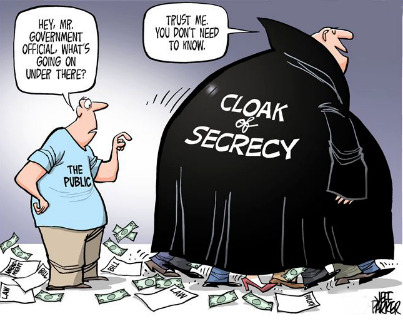This is a humorous take on our penchant for secrecy, the kind that evokes nostalgic mirth. It is not meant as criticism. Of course we have our reasons for secrecy and most of these are valid reasons. Humour, of course, obtains from those quaint situations and anecdotes that arise from this ubiquitous penchant.

Armed forces personnel are, by nature, secretive and suspicious. I must have had traits of a potential fauji at very early stages of my life. As kids, we were of impressionable age when the Indo-Pak War of 1965 started. We were in the town of Mandi in Himachal Pradesh. Our group of 11 to 12 year olds had felt that what stood between the country’s continued freedom and hostile destruction was – to a large measure – our vigilance. Inspired by the news on All India Radio wherein Paki spies routinely disguised themselves as sadhus and beggars, every such person visiting our colony was subjected to intense search and scrutiny. One or two of them were severely beaten up for not being able to prove their identities. A Horticulture (my dad’s chosen field of work) Colony was coming up in Jawahar Nagar (now must be called Sonia or Rahul Nagar in keeping with the equivalent penchant of our netas) and the labourers were mainly of Tibetan origin. They were living in tents across our house and used to cook on wood. One night – the first night after we had finished putting carbon paper on all glass window panes so that no light would show outside during black-outs – our vigilant group spotted these Tibetans cooking on wood-fires. We felt that these were open invitations for the PAF Canberras to bomb the hell out of us. So, we stridently ordered the labourers to take their fires inside the tents; much against their protests. After about 30 minutes of their complying with our orders, two of the tents caught fire and it took us hours to put out the fires. Luckily, PAF Canberras were not as vigilant as we were.
Ten years later, I joined the Indian Navy as a commissioned officer and realised that my sense of secrecy was still precocious; I had much more to learn. As a Lieutenant I was made a member of a pricing board for buying fresh vegetables. Those days, rations were not supplied to us by the naval Base Victualing Yard (BVY) but through the ASC or Army Supply Corps depot in what we had erroneously been thinking of as naval area but was later confirmed as military area because of the Army’s penchant to hold land even in naval stations. I was stunned to see that the proceedings of this board were marked SECRET. I was thinking of it as a misprint but the board president, a Colonel, assured me otherwise. Later, when I became married, and started receiving those free rations (subsequently called entitled rations so that our civilian counterparts would not exercise their own penchant for always bringing out that freebies were given to us at the drop of a hat), I knew that marking them SECRET was the right thing to do; even I would have wanted them to be SECRET so that others won’t see my mortification at their poor quality. There is always a reason!
Often, the marking of classification evokes curiosity in others. It is somewhat similar to the boss telling the secretary: “Mark this SECRET; I want everyone in the office to read it”. Take social media, for example; you painstakingly put up your posts on which you spend hours researching. However, no one reads them including those who press the Like button. However, if there was some way you could tell people that it has information meant only for the few select ones, see how fast the readership would grow. At one time, the information about Pak Navy assets including weaponry and missiles was SECRET and all of us knew the details like the back of our hands. And then it occurred to Naval Headquarters as to why should stuff that had been gleaned from Jane’s publications be SECRET; so they made it unclassified. End of our curiosity and their being widely known! I can imagine the Naval Intelligence officers exchanging chuckles whilst reading this; they know they were engaged in something useful all these years by passing off news items as intelligence.

Now, I am sharing with you another source of real intelligence for the naval community in Mumbai, during our days: the newspaper vendor called ODI Mendon. Lets say a friend of yours owed you money (a realistic scenario) and he told you that as soon as he’d get his pay (an unrealistic scenario) he’d return the money since during those days you received your pay in cash. On the first of the next month when you went by you mobike (with the last drops of petrol in it) to extract your owing from him, you found that his ship had sailed. It was a catastrophe and only the hope of the ship’s return would provide you with some silver lining. However, the ships’ movements are highly classified and you can’t get information from anywhere. If you thought hard, you’d find that ODI Mendon was the answer. He’d tell you when exactly the ship would be back; they having stopped the newspaper with him, before sailing, for a specific number of days. He would also tell you which other ships and submarines had sailed. Similarly, MM Pajni, the LIC agent would tell you the ships’ programme as he knew when exactly to come to Naval Dockyard and collect the due premiums of the Life Insurance policies.
But, SECRET or even TOP SECRET doesn’t attract as much curiosity as something called PERSONAL AND CONFIDENTIAL (P&C). As a young Lieutenant I was posted as an instructor in Navy’s Leadership School INS Agrani at Coimbatore. Our CO, we came to know through rumours, was being overlooked for promotion. During those days, officers received P&C letters regarding the status of their promotions. So, when such a letter arrived at Agrani, curiosity got the better of us. We broke the seals, opened the letter and read how the Navy is such a pyramidal structure and how at various stages some people, however outstanding they are, have to fall off; and so on. The problem was how to put it back: there was an outer ordinary cover and then there was a sealed cover inside; whose seals now had perished. So the Captain’s Secretary (Cap Sec) overnight got a seal manufactured and on the next forenoon the operation of resealing it was done. During those days, it cost him a bomb.
 When the CO arrived next day and the mail presented to him, he took out the sealed envelope, didn’t even open it, gave it to his Cap Sec and said, “Just open it and file it in my P&C File. It is a letter from ACOP (Assistant Chief of Personnel); I am not making it to the next rank.” Cap Sec felt like a heel.
When the CO arrived next day and the mail presented to him, he took out the sealed envelope, didn’t even open it, gave it to his Cap Sec and said, “Just open it and file it in my P&C File. It is a letter from ACOP (Assistant Chief of Personnel); I am not making it to the next rank.” Cap Sec felt like a heel.
The most curious incident of this misplaced secrecy was a signal regarding the movement of one of our Chiefs of Naval Staff (CNS) who was accorded high security due to our operations in Sri Lanka against the LTTE (Liberation Tigers of Tamil Eelam). Hence, whilst a MOVREP (Movement Report) signal is generally unclassified, his MOVREP signals used to be SECRET and encrypted accordingly. As CCO (Command Communication Officer) it was my duty to decrypt them and show them to only the C-in-C and the Chief of Staff (COS). The MOVREP signal is in a format that reads: Name, rank, number, designation, arrival date and time, from where arriving and how (train, air etc), purpose of visit, number of days of visit, departure date and time, and whether transport and mess accommodation are required and any other information. I showed the decrypted signal to COS and he remarked, “By making it SECRET, at least his movements are now classified and not known to everyone.” I disagreed and showed him three unclassified MOVREP signals of three Naval Headquarters officers received simultaneously. In the palce about how were they arriving, each one of them had dutifully written: ‘By CNS Aircraft’.
This was like the parts of those messages received at sea wherein the classified words were coded in Naval Tactical Code. So a signal would read something like: “Call-sign F1 (say Fleet Commander) would be airborne from 1630 to 1715 hours by NATCO blah blah blah blah UNNATCO”. You didn’t even have to decode it to bring out that blah blah blah blah meant HELO. Only the absolute dumbo would imagine that Fleet Commander would be airborne by KITE or BIRD!
Life goes on. Some of our things are so SECRET that even we don’t have any idea of what they are.

